

Effective Classroom Management in Physical Education: Strategies for Beginning Teachers. JOPERD Table of ContentsDan Grube, Stu Ryan, Sarah Lowell, & Amy Stringer Classroom management is often a big concern for beginning teachers.
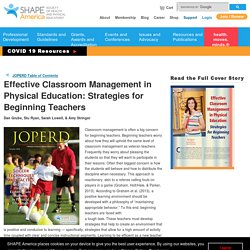
Beginning teachers worry about how they will uphold the same level of classroom management as veteran teachers. Frequently they worry about pleasing the students so that they will want to participate in their lessons. Often their biggest concern is how the students will behave and how to distribute the discipline when necessary. This approach is reactionary, akin to a referee calling fouls on players in a game (Graham, Holt/Hale, & Parker, 2013). Efficient use of time in physical education classes is critical given the limited amount of physical education that children receive in schools today. Another study looked at how teachers’ classroom management has changed over time (Garrahy, Cothran, & Kulinna, 2002). To read the rest of this article, click here to download a pdf.
Classroom Physical Activity. Classroom physical activity is any physical activity done in the classroom.1-4 It can take place at any time and occur in one or several brief periods during the school day. 1-4 It includes integrating physical activity into academic instruction as well as providing breaks from instruction specifically designed for physical activity.1-4 Classroom physical activity should be offered in addition to physical education and recess and at all school levels (elementary, middle, and high school).
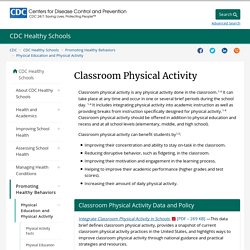
Classroom physical activity can benefit students by1,5: Improving their concentration and ability to stay on-task in the classroom.Reducing disruptive behavior, such as fidgeting, in the classroom.Improving their motivation and engagement in the learning process.Helping to improve their academic performance (higher grades and test scores).Increasing their amount of daily physical activity. Academic Departments / P/E Class Rules.
"The will to win is important, but the will to prepare is vital.
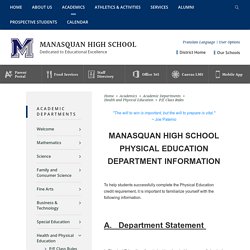
"~ Joe Paterno To help students successfully complete the Physical Education credit requirement, it is important to familiarize yourself with the following information. A. Department Statement In Physical Education, the student is educated by means of physical activity. The program contributes to the use of physical activities for personal development in the areas of physical fitness, motor abilities, mental abilities, and social abilities. It is the aim of physical education to provide an opportunity for the individual to act in situations that are physically healthy, mentally stimulating, satisfying, and socially sound. Physical Education / Rules and Regulations. PE Class Expectations: Rules, Consequences, and Grading - Mike Gorman's PE site.
My name is Mike Gorman, and I am one of your child’s P.E. teachers for the 2012-2013 school year.
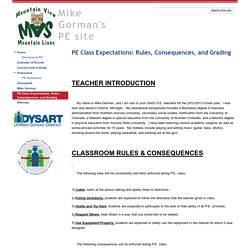
I was born and raised in Detroit, Michigan. My educational background includes a Bachelors degree in business administration from Northern Arizona University, secondary social studies certification from the University of Colorado, a Masters degree in special education from the University of Northern Colorado, and a Masters degree in physical education from Arizona State University. I have been teaching various academic subjects as well as extracurricular activities for 15 years.
My hobbies include playing and writing music (guitar, bass, drums), traveling around the world, playing basketball, and working out at the gym. The following rules will be consistently and fairly enforced during P.E. class: 1) Listen- looks at the person talking and quietly listen to directions. 2) Follow Directions- students are expected to follow the directions that the teacher gives in class.
7 Tips for Effective Classroom Management in Physical Education. With increasing class sizes in the gym, maintaining order can become difficult if you do not have the proper guidelines in place.
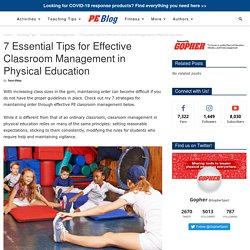
Check out my 7 strategies for maintaining order through effective PE classroom management below. While it is different from that of an ordinary classroom, classroom management in physical education relies on many of the same principles: setting reasonable expectations, sticking to them consistently, modifying the rules for students who require help and maintaining vigilance. Create routines for entering the gym or outside play area, getting out equipment, beginning games, putting equipment away and exiting class. Once students know what to expect, they will be able to channel their excitement and energy into meaningful action.Learn your students’ names. This is the singular most important tactic in ensuring an efficient classroom. There are so many PE teachers (elementary and secondary) that have effective behavior management strategies already in place.
Class Rules for PE - Free Download of NASPE-Aligned Physical Education (PE) Lesson Plans. PEC: Physical Education Rules.